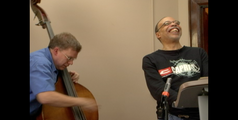Time Forms: The Temporalities of Aesthetic Experience
September 18-21, 2013 McGill University and the Phi Centre
Presented by the Institute for the Public Life of Arts and Ideas (IPLAI), Centre for Interdisciplinary Research in Music Media and Technology (CIRMMT), the Schulich School of Music and ICASP (Improvisation, Community, and Social Practice), in collaboration with the McGill Sustainability Fund, Media@McGill, the McGill Institute for Gender, Sexuality and Feminist Studies, the Moving Image Research Laboratory, The Urban Night as Interdisciplinary Object Project, Immediations: Art, Media and Event, the Dean of Arts Development Fund and the Music Perception and Cognition Laboratory
Registration is required, and is free and open to the public; some events have limited seating/ participation available.
Description
“Time Forms: Temporalities of Aesthetic Experience” is a four-day major research-creation workshop that explores the ‘when’ of art today, held at McGill University and the Phi Centre in Montreal from September 18-21, 2013, curated by Eric Lewis (Philosophy), Stephen McAdams (Music Research) and Alanna Thain (English and World Cinemas) of McGill University. Bringing together scholars, artists, curators and the public, this event will investigate art events that intimately involve a temporal dimension, in order to explore different concepts, kinds and components of temporality in the expe riencing of art. In exploring such questions as: ‘what concepts of time are relevant to the experience of art?’; ‘what are the ways in which time plays a role in such experiences?’ and ‘what qualities are specific to time-based arts?’, Time Forms addresses art today as a critical site for resisting the homogenization of a modern “clock time” that subdivides duration into discrete and identical units. Do aesthetic experiences give us unusual experiences of time, and if so, how and to what end? How does art “make time felt”?
This event aims to explore forms in time and the ways time forms experience by bringing together scholars and creators of artistic media that intimately involve a temporal dimension in the experience they engender. Participants will explore different concepts, kinds and components of experiential temporality as they are manifested in a variety of artistic forms. The event itself is designed to have a large-scale temporal structure that modulates the temporal experience of continuity, immersion and distraction over the whole event, within which are embedded smaller structures with an interleaving of thought-provoking scholarly presentations, performances or presentations of art forms, creative workshops, and moments of repose, reflection and nourishment or other modes of distraction such as moving around space to get to different events, thereby discovering spaces in between the events.


